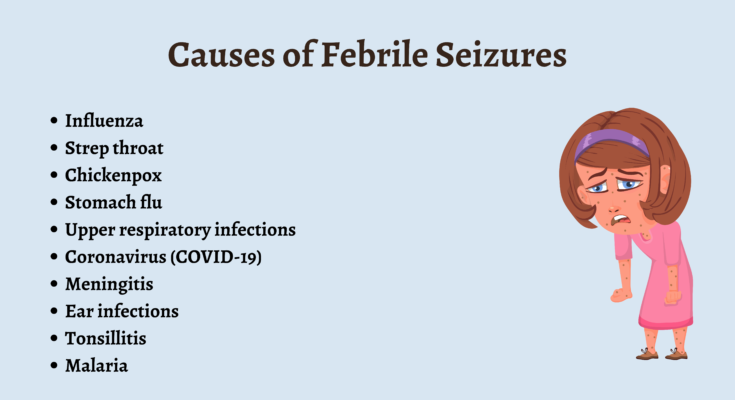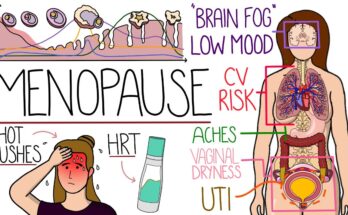Febrile Seizure Symptoms: Febrile seizures represent a significant concern for parents and caregivers worldwide, occurring in 2-5% of children between the ages of 6 months and 5 years.
This medical condition, characterized by convulsions brought on by a fever, often sparks fear and confusion.
Our comprehensive guide aims to demystify febrile seizures, providing detailed insights into their symptoms, causes, and essential management strategies.
Understanding Febrile Seizures
Febrile seizures, a common childhood health concern, present a frightening experience for many parents. Defined as convulsions associated with a fever in young children, they typically occur without any underlying neurological issue. This article delves into the definition of febrile seizures, their prevalence, the age group most affected, and how they differ from other types of seizures, providing essential information for understanding this condition.
Statistics: Prevalence and Age Group Most Affected
Febrile seizures affect approximately 2-5% of children before the age of 5, making them the most common type of seizures in this age group. The peak incidence occurs in toddlers aged 12-18 months, highlighting a critical period where parents and caregivers should be particularly vigilant for signs of sudden fever and convulsions.
Differentiating Between Febrile Seizures and Other Types of Seizures
Understanding the difference between febrile seizures and other types of seizures is crucial for proper response and treatment. Febrile seizures are specifically tied to fevers and do not occur due to an underlying neurological disorder. In contrast, epilepsy and other seizure disorders can cause seizures without the presence of fever and may have different triggers, symptoms, and treatment requirements. Febrile seizures are typically less concerning to neurologists, given their direct link to fever and the general absence of neurological impairment.
Recognizing the signs of febrile seizures and understanding their nature can alleviate concerns and help parents manage the situation more effectively. By distinguishing febrile seizures from other types of seizures, caregivers can ensure that children receive the appropriate care and attention during these alarming but often benign episodes.
Symptoms of Febrile Seizures
Understanding the symptoms and knowing when to seek medical attention are crucial for parents and caregivers. This guide aims to provide a comprehensive overview of febrile seizure symptoms, highlight warning signs for when to seek medical help, and share first-hand accounts to offer insights into real-life experiences with febrile seizures.
Detailed Description of Febrile Seizure Symptoms
Febrile seizures are associated with a range of symptoms that can be startling to witness. Key indicators include:
- High Fever: A sudden spike in body temperature, often above 100.4°F (38°C), is the primary trigger for febrile seizures.
- Convulsions: The child may experience full-body convulsions, which include shaking, twitching, or jerking movements of limbs. These convulsions are involuntary and can last for several minutes.
- Loss of Consciousness: During the seizure, the child may lose consciousness or appear unresponsive.
- Rigidity: Muscles may become stiff or the child may have difficulty moving.
- Rolling Eyes: Eyes may roll back or the child may not be able to focus.
- Crying or Moaning: The child may cry or moan, especially at the onset of the seizure.
Warning Signs: When to Seek Medical Attention
While febrile seizures often end without long-term consequences, certain symptoms warrant immediate medical attention:
- Duration: If the seizure lasts more than 5 minutes, it’s essential to seek emergency medical care.
- Recurring Seizures: Multiple seizures within a 24-hour period are a sign to contact your healthcare provider.
- Breathing Difficulties: Difficulty breathing during or after the seizure is a critical sign of distress.
- Extreme Lethargy: If the child is unusually drowsy or unresponsive after the seizure, medical help should be sought.
- First Seizure: If it’s the child’s first febrile seizure, a medical evaluation is necessary to rule out other causes and to provide guidance.
First-Hand Accounts or Case Studies
First-hand accounts of febrile seizures from parents and caregivers can offer additional perspective and reassurance. For example, a parent shared that witnessing their child’s first febrile seizure was terrifying, but understanding that these seizures are generally not harmful eased their anxiety. Another case study highlighted the importance of staying calm and timing the seizure, which helped the parents communicate effectively with healthcare professionals and ensure their child received appropriate care.
Febrile seizures can be frightening to witness, but with the right knowledge and actions, caregivers can manage these episodes more confidently. Recognizing the symptoms, understanding when to seek medical help, and learning from the experiences of others are key steps in navigating the challenges of febrile seizures.
Causes and Risk Factors of Febrile Seizures
Understanding the causes, risk factors, and separating fact from fiction is crucial for managing and preventing these incidents. This guide delves into how high fevers can lead to seizures, outlines common illnesses associated with febrile seizures, highlights risk factors, and debunks prevalent myths.
How High Fever Leads to Seizures
Febrile seizures typically occur in children between the ages of 6 months and 5 years, triggered by a rapid increase in body temperature, often above 100.4°F (38°C). The precise mechanism is not fully understood, but it’s believed that the rapid fever escalation affects the brain’s electrical activity, leading to a seizure. These events, although alarming, are usually short-lived and rarely cause long-term health issues.
Common Illnesses Associated with Febrile Seizures
Several common childhood illnesses can precipitate febrile seizures, with viral infections being at the forefront. Influenza, the common cold, roseola, and ear infections are notable examples. Additionally, vaccinations, particularly the measles, mumps, and rubella (MMR) vaccine, have been linked to an increased risk of febrile seizures. It’s important to note, however, that the benefits of vaccinations far outweigh the risk of febrile seizures.
Risk Factors for Developing Febrile Seizures
While any child with a fever can experience a febrile seizure, certain factors increase the risk. These include:
- Age: Children between 6 months and 5 years are at the highest risk, with the peak occurrence around 14-18 months.
- Family History: A family history of febrile seizures in close relatives increases the likelihood.
- Previous Seizures: Having had one febrile seizure elevates the risk of experiencing another.
Debunking Myths and Misconceptions
Myths surrounding febrile seizures often cause unnecessary panic. Contrary to common beliefs, febrile seizures:
- Do Not Cause Brain Damage: Scientific evidence shows no link between typical febrile seizures and future cognitive or developmental issues.
- Are Not Epilepsy: While they involve convulsions, febrile seizures are not classified as epilepsy, which involves recurrent, unprovoked seizures.
- Do Not Predict Lower IQ: There’s no correlation between febrile seizures and a decrease in intelligence later in life.
However, febrile seizures are a symptom of underlying febrile illness in young children and are influenced by several risk factors, including age, family history, and prior occurrences. By understanding these aspects and debunking the myths, caregivers can approach febrile seizures with knowledge and calm, ensuring the best care for their child.
Diagnosis and Evaluation of Febrile Seizures
Understanding the process of diagnosis and evaluation can help parents and caregivers navigate through these alarming yet often benign events.
How Febrile Seizures are Diagnosed
Diagnosing febrile seizures primarily involves observing the child’s symptoms and assessing their medical history. Typically, these seizures occur in the absence of an underlying neurological disorder, making the presence of a fever a critical diagnostic criterion. Pediatricians often differentiate between simple and complex febrile seizures based on the duration of the seizure and whether it’s localized to one part of the body or involves the entire body. A simple febrile seizure is short and doesn’t recur within a 24-hour period, while a complex febrile seizure may last longer, occur more than once within 24 hours, or be focal, affecting only one part of the body.
Medical Tests and Evaluations (If Necessary)
While not all children require extensive testing, certain situations warrant further evaluation. For instance, if the seizure is complex or prolonged, if there’s concern for a central nervous system infection (like meningitis or encephalitis), or if the child has a history of neurological problems, additional tests may be recommended. These could include:
- Blood Tests: To check for signs of infection, electrolyte imbalances, or other conditions that could trigger seizures.
- Lumbar Puncture: Performed if there’s a suspicion of meningitis or encephalitis.
- Electroencephalogram (EEG): Though not routinely required, an EEG may be used to rule out epilepsy in certain complex cases.
- Imaging Tests: Magnetic Resonance Imaging (MRI) or Computerized Tomography (CT) scans are not standard for febrile seizure diagnosis but may be utilized if structural brain abnormalities are suspected.
The Role of Medical History in Diagnosis
A thorough medical history plays a pivotal role in diagnosing febrile seizures. Pediatricians will inquire about the child’s overall health, any previous seizures, and the family’s history of febrile seizures or epilepsy. Understanding the circumstances surrounding the seizure, such as how long it lasted, the fever’s onset, and any symptoms before or after the seizure, provides crucial diagnostic insights. Additionally, documenting the type of fever-causing illness can help differentiate febrile seizures from other conditions.
Parents and caregivers should focus on fever management and, following a febrile seizure, consult with a pediatrician to understand the event and how to prepare for future fevers. Understanding these key components in the diagnosis and evaluation of febrile seizures empowers caregivers to provide optimal care for their child.
Treatment and Management of Febrile Seizure
Understanding the immediate steps to take during a seizure, long-term management strategies, and how to reduce fever and seizure risks are crucial in ensuring the well-being of a child experiencing febrile seizures. Here’s a comprehensive guide to help you navigate through these situations.
Immediate Steps to Take During a Febrile Seizure
- Stay Calm: Keeping calm will help you manage the situation more effectively.
- Ensure Safety: Place the child on a soft surface, lying on their side, to prevent choking and keep their airway clear.
- Time the Seizure: Note how long the seizure lasts. Febrile seizures typically last for a few minutes.
- Do Not Restrain: Avoid holding or restraining the child’s movements.
- Remove Obstacles: Clear the area around the child to prevent injury.
- Avoid Oral Intervention: Do not attempt to put anything in the child’s mouth; this could cause injury.
- Seek Medical Attention: If the seizure lasts more than 5 minutes, is accompanied by breathing difficulties, or if it’s the child’s first seizure, seek immediate medical help.
Long-term Management Strategies
- Education and Awareness: Understanding febrile seizures and knowing how to react can alleviate anxiety and improve management.
- Regular Medical Check-ups: Regular visits to a pediatrician can help monitor the child’s overall health and manage any recurring seizures.
- Seizure Plan: Develop a seizure action plan with your healthcare provider that includes when to seek medical help and how to administer first aid.
Medications and Interventions
- Fever Management: Antipyretics, such as acetaminophen or ibuprofen, can be used to manage fever under a doctor’s guidance.
- Seizure Medications: In some cases, a doctor may prescribe anticonvulsant medication to prevent recurrent seizures.
- Vaccinations: Ensure the child is up to date on vaccinations, as some febrile seizures are triggered by infections that vaccines can prevent.
Tips for Parents and Caregivers to Reduce Fever and Seizure Risks
- Fever Management: Keep a digital thermometer handy to monitor fever accurately. Administer fever-reducing medication as recommended by your pediatrician.
- Stay Hydrated: Encourage the child to drink plenty of fluids to prevent dehydration.
- Cool Environment: Dress the child in light clothing and keep the room at a comfortable temperature to help reduce fever.
- Infection Prevention: Practice good hygiene and encourage handwashing to reduce the risk of infections that could lead to febrile seizures.
- Educate Caregivers: Make sure all caregivers, including family members and babysitters, are aware of the child’s condition and know how to act in case of a seizure.
Febrile seizures are usually not harmful to the child in the long term, but knowing how to effectively manage them can help prevent complications and give peace of mind to parents and caregivers. Always consult with a healthcare provider for personalized advice and treatment options tailored to the child’s specific needs.
Prevention and Proactive Measures for Febrile Seizures
Understanding how to reduce the risk can empower you in managing and preventing these episodes. Here are critical strategies including vaccinations, lifestyle adjustments, and knowing when to consult a pediatrician.
Vaccinations and Their Role in Prevention
Vaccinations play a pivotal role in preventing febrile seizures. Certain illnesses, like influenza and the measles, can trigger a high fever and subsequently a febrile seizure. Ensuring your child is up-to-date with their vaccination schedule is a key step in minimizing this risk. Research indicates that vaccinations can significantly reduce the occurrence of febrile seizures by preventing these underlying illnesses. Always discuss your child’s vaccination plan with your pediatrician to ensure optimal protection.
Lifestyle and Environmental Factors
A healthy lifestyle and a safe environment can also contribute to the prevention of febrile seizures. Here are a few tips:
- Maintain a Fever-Reducing Environment: Keep your child cool during hot weather and appropriately dressed. Avoid overdressing or underdressing, as both can lead to temperature spikes.
- Hydration is Key: Ensure your child stays well-hydrated, especially during illness, to help regulate body temperature.
- Regular Sleep Patterns: Adequate rest is crucial. Lack of sleep can make children more susceptible to illnesses that cause fevers and, consequently, febrile seizures.
- Stress Reduction: Although it’s less directly linked, minimizing stress in your child’s environment can support their overall health and immunity, reducing the chances of febrile seizures.
When to Consult a Pediatrician for Preventive Measures
Knowing when to seek medical advice is crucial in preventing febrile seizures. Here are situations when you should consult a pediatrician:
- Before the Fever Hits: If your child has a history of febrile seizures, discuss preventive measures with your pediatrician. They may recommend fever-reducing medications as a proactive step during illnesses.
- Vaccination Consultation: Always stay on schedule with vaccinations, but consult your pediatrician if your child has had a febrile seizure in the past. They can provide advice tailored to your child’s health history.
- After a Febrile Seizure: If your child experiences a febrile seizure, it’s essential to see a pediatrician. They can investigate the cause of the fever and check for any underlying conditions.
Febrile seizures can be frightening, but with the right knowledge and proactive measures, you can significantly reduce the risk and ensure your child’s well-being. Always work closely with your pediatrician to tailor a prevention plan that suits your child’s needs.
FAQs: Understanding Febrile Seizures
What are Febrile Seizures?
Febrile seizures are convulsions that can happen in young children due to a spike in body temperature, often from an infection. Typically affecting children between 6 months and 5 years old, these seizures are the most common type of childhood seizure and are usually linked to a rapid increase in fever.
What Causes Febrile Seizures?
Febrile seizures are triggered by a rapid increase in body temperature, often due to infections like the flu or common cold. In some cases, vaccinations can also lead to a high fever, potentially triggering a febrile seizure.
Are Febrile Seizures Serious?
Most febrile seizures are short-lived and don’t lead to long-term health issues. They can be frightening to witness, but they typically don’t cause brain damage, learning disabilities, or epilepsy. However, prolonged seizures (lasting more than 15 minutes) require immediate medical attention.
What Are the Symptoms of a Febrile Seizure?
During a febrile seizure, a child may:
- Lose consciousness
- Shake or twitch limbs
- Roll their eyes back
- Become stiff or limp
After the seizure, the child might be sleepy or irritable for a short period.
How Can I Help My Child During a Febrile Seizure?
If your child is having a febrile seizure, remain calm and follow these steps:
- Lay them on their side to help with breathing
- Clear the area around them to prevent injury
- Do not restrain them or put anything in their mouth
- Check the time; if the seizure lasts longer than 5 minutes, call emergency services
- After the seizure, seek medical advice to address the underlying fever and assess the need for further evaluation.
Can Febrile Seizures Be Prevented?
While it’s not always possible to prevent febrile seizures, managing your child’s fever can help reduce the risk. Use fever-reducing medications as advised by your healthcare provider and keep your child cool and comfortable during a fever.
When Should I See a Doctor?
You should seek immediate medical attention if:
- It’s your child’s first febrile seizure
- The seizure lasts more than 5 minutes
- Your child shows signs of distress or difficulty breathing
- Your child does not return to their normal state after the seizure
For further guidance and support, consult with your pediatrician or a healthcare professional specializing in child neurology.
Conclusion:
This discourse underscores a critical call to action for education and awareness among caregivers and the broader community. Knowledge, after all, is more than mere information; it is a tool that empowers, a light that guides, and a bridge to better outcomes. Caregivers, armed with understanding and empathy, become invaluable allies in the journey towards wellness, providing support that is both informed and insightful.
Therefore, let us champion the cause of health education and advocate for increased awareness. In doing so, we pave the way for a future where caregiving is informed by knowledge, guided by compassion, and inspired by a collective commitment to foster health and well-being for all.
In conclusion, recognizing symptoms and understanding their causes are crucial elements that enable effective caregiving and medical intervention. Let’s embrace the pursuit of education and awareness, empowering ourselves and others to make informed decisions and provide the best care possible. Together, we can build a healthier, more informed world.
References
For those seeking more information on febrile seizure symptoms and wishing to verify the information provided, we have compiled a list of reputable sources. These references can offer deeper insights and a broader understanding of febrile seizures, aiding in better comprehension and management of the condition.
- Centers for Disease Control and Prevention (CDC): The CDC’s page on febrile seizures provides comprehensive information on the symptoms, causes, treatment, and prevention of febrile seizures. It serves as a reliable resource for parents, caregivers, and healthcare professionals. Read more about Febrile Seizures at CDC.
- Mayo Clinic: Known for its patient-centered healthcare advice, the Mayo Clinic offers a detailed overview of febrile seizures, including symptoms, risk factors, and when to seek medical advice. Their guide is an excellent resource for understanding how febrile seizures affect children. Explore Febrile Seizure Information on Mayo Clinic.
- National Health Service (NHS) UK: The NHS provides practical advice on what to do if your child experiences a febrile seizure. It also explains the different types of febrile seizures and how to care for a child after a seizure. Visit NHS for Guidance on Febrile Seizures.
- Epilepsy Foundation: As a leading group in epilepsy research and education, the Epilepsy Foundation offers insights into the link between febrile seizures and the development of epilepsy. Their resources can help differentiate between febrile seizures and other types of seizures. Learn about Febrile Seizures at the Epilepsy Foundation.
- American Academy of Pediatrics (AAP): The AAP’s page on febrile seizures is geared towards pediatric care, providing guidelines for diagnosis, treatment, and management. It’s an essential read for healthcare professionals and parents alike. Check AAP Guidelines on Febrile Seizures.
Each of these sources offers valuable perspectives and data on febrile seizures. Whether you’re a concerned parent, caregiver, or healthcare professional, accessing this information can enhance your knowledge and preparedness to handle febrile seizures effectively.



